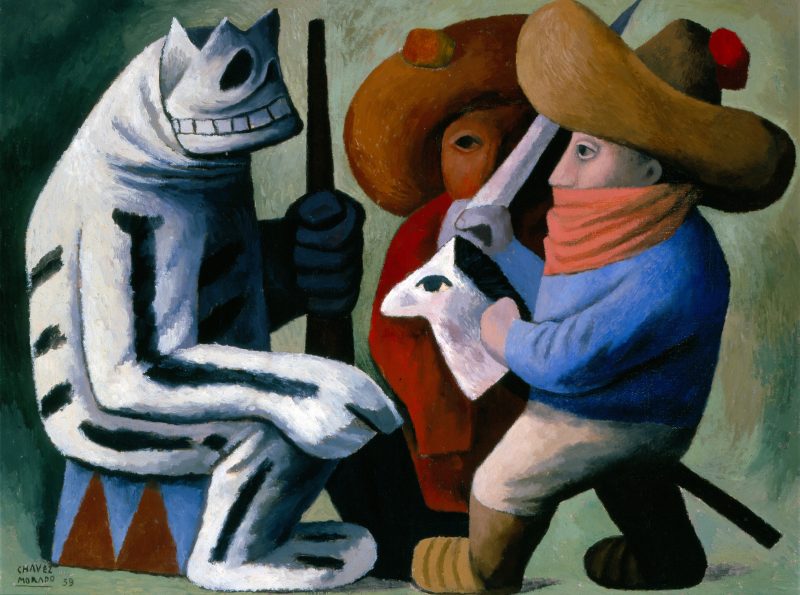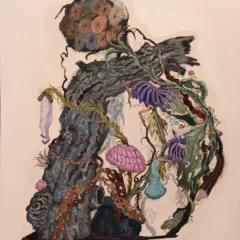Paint the Revolution: Mexican Modernism, 1910-1950
October 25, 2016 – January 8, 2017 at the Philadelphia Museum of Art
Art Review, February 2017
By Steve Basel

In Paint the Revolution: Mexican Modernism. 1910-1950 – at the Philadelphia Museum of Art, the cosmic, imaginary and mundane lose their distinction. Here, blissful bucolic fantasies like Rufino Tamayo’s, The Dance (1924), and the steamy bedazzling visions of Adolfo Maugard are hung across from Jose Clemente Orozco’s paintings of warfare devoid of meaningful purpose. Maugard’s ornate pattern and Tamayo’s dance both ignore and negate the neo-feudal conditions of the revolution’s agrarian genesis, escaping to a much-needed future; while Orozco ignores the post-revolutionary future’s potential in order to preserve the abhorrent reality of its past.
The revolution refers to a moment, roughly between 1911 and 1917, when the people of Mexico formed temporary coalitions across party, class, and ethnicity – to turn the instruments of oppression: juridical, ideological, proprietary, industrial, and educational, under the regime of Porfirio Diaz, into those of their liberation. The exhibition is comprised of some 280 works from the most prodigious Mexican artists and cultural producers; full of political journals, music, photography, painting, sculpture, and even murals projected on the gallery walls each holding a distinct presence, attitude and poetry. The scope of this exhibit, accounting for the many variations of style, media, message and manner of presentation; is overwhelming.
The PMA’s thematic organization of work is best exemplified by the conflict between the Stridentists and the Contemporaries; avant-garde groups active in the 1920’s. The Stridentist’s, incorporating dada and cubo-futurist design sought to give modern form and voice to a unified revolutionary spirit – whereas the Contemporaries – floated above any literal representation of socio-political transformation in a surrealist mode of thought and European style intellectualism. From the mid-twenties onward, while civilian alliances began to splinter, the government began to reconstitute itself and its power through assassination, political repression and realignment with foreign interests, all whilst remembering how the masses had once taken the streets by force.
The Zapatistas, a painting by Alfredo Ramos Martinez from 1932, is one such image of subaltern strength and civilian power. As we look downward into a group of soldiers cut by the frame, a resolute stare pierces upward and out from within a maelstrom. Sombreros cruise like boats over a torrent of Zapata revolutionaries, and like icebergs, they conceal a massive body beneath. The interplay of bright bulbous shapes atop a warm cavernous gathering conveys a course but bubbling intensity.
Martinez’s arid handling imbues this claustrophobic scene with the whipping emptiness of a desert. Here weapons obscure hands, hands obscure faces, and a face then of one man distracts from all. He remains both intimately unknown and joined in common struggle; a single cell in a larger organism of change.
In a 1924 issue of Corrido’s El Machete – the official paper of the Mexican Communist party, revolutionary change itself is transmogrified into a distinct force of energy reverberating through the hot purple woodblock print The Earth Belongs to those who work with Their Hands, by: David Siquerios and Xavier Guerrero. An undulating banner hovers between a terrestrial assembly and a corporate ghoul above, bringing to mind The Tennis Court Oath by French Neoclassical painter Jacques-Louis David.
During the war, just as Martinez’s Zapata soldier stares out, 1.5 million Mexicans gazed into the hollow eyes of death. In Carnival in Huejotzingo, by Jose Chavez Morado, from 1939, we see this transitory moment of existential confrontation prolonged through festive reenactment. A saber rattling child dressed as a cowboy blankly stares into the black painted eyes of a skeleton who leers back, smugly gripping a rifle. Death sits personified, shrouded in costume, with club-like hands and an oafish body. Morado’s droll charm engages with the way we reanimate our dead through remembrance and the ongoing battle to determine their meaning in the stories told by the living.
In this show we stroll through the stories of the people of Mexico as briskly as we might flip through a newspaper, or a digital feed; seeing bloodshed, jubilance, disaster, and maybe a punchline or two. Walking from room to room, back and forth, from one representation of unity to another, what appears as a cacophony of incompatible voices becomes one kaleidoscopic entity. Where two works might have been straightforwardly opposed, a common attraction, impulse, aesthetic or theme, would expose a subtle bond. These multifarious bonds begin multiplying, and overlapping; building momentum here, pivoting the pattern there, inside the confines of this space. This amassing of subjectivities builds an emergent consciousness that we speak to and compare to our own modern world. Though the particular style is now easily limited by its art historical categorization many issues remain open due to their continuing resonance in our present day. Paint the Revolution is not something that remains in the past, but is a challenge, to make tangible and modern the vision of the world we still long for.
Steve Basel earned his MFA from the the Pennsylvania Academy of Fine Art in 2014 and his BFA from the Cleveland Institute of Art in 2012 in painting. He is a current member of Automat collective. Occasionally he writes about art; regularly contributing reviews to Title Magazine. Artistically his focus is in painting but experiments with a wide range of media to support his practice.









